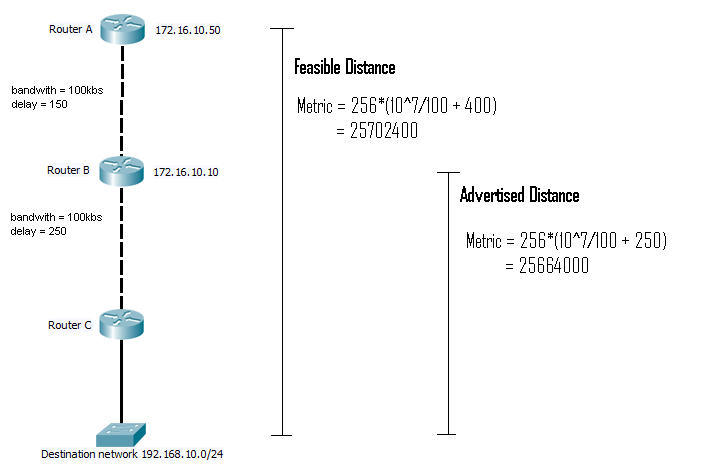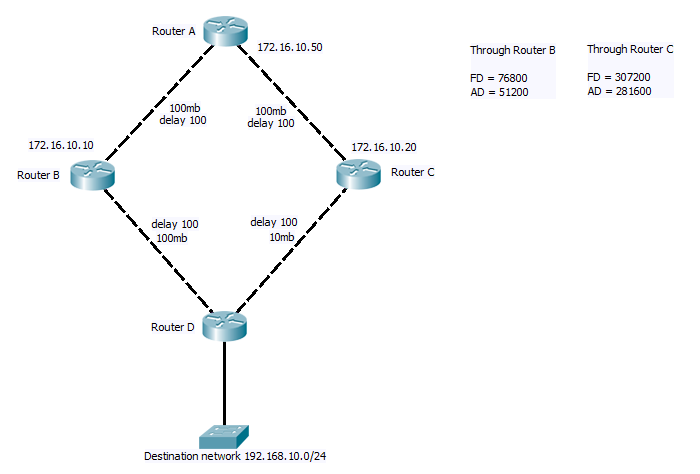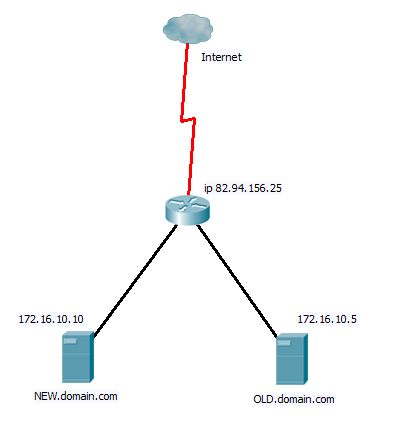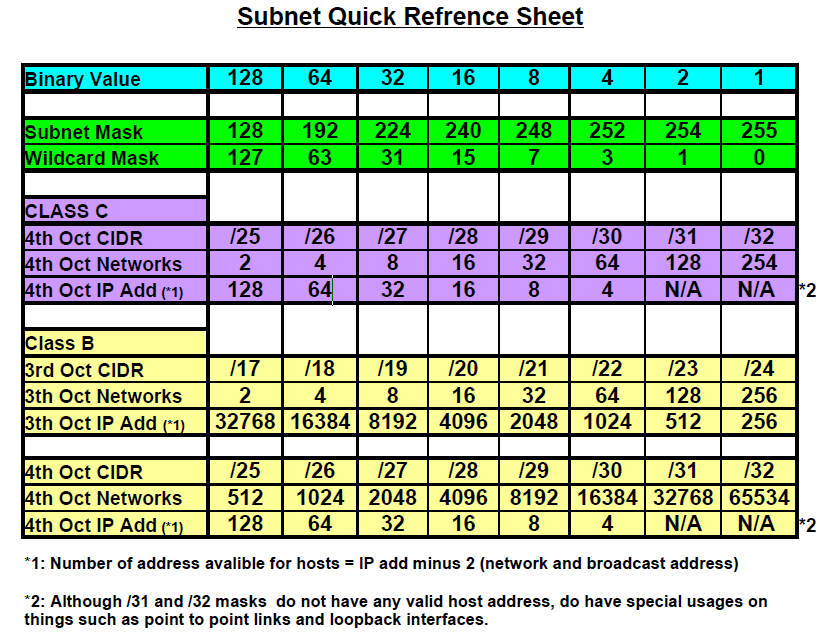OK so been reading the intro to EIGRP, now its time to get configuring, I think the best way to remember these is to take each one in turn and describe its function. Starting with the global commands, then the EIGRP specific commands, followed by some of the interface commands, and ending with a few basic verification commands. (For this post the configured name of the router will be “R1”)
GLOBAL COMMANDS.
R1(config)#ip routing.
This command is enabled by default on routers and disabled on layer 3 switches (some newer IOS do seem to have it enabled). Running this command enables routing on the device, with out it no routing of any kind will be preformed by the switch.
R1(config)#ip route <ip address> <subnet mask> <next hop address>
This command set a static route entry, not strictly EIGRP but important enough to know to be here. The next hop address can by an ip address to forward the traffic to, or jsut the interface to send the traffic out. It is considered best practice to if possible specify an ip address if possible. One common route entered this way is the “default route”
R1(config)#ip route 0.0.0.0 0.0.0.0 <next hop address / interface>
This sets the destination to pass all unknown traffic to, traffic that there is no specific entry in the routing table for.
R1(config)#router eigrp <AS number>
Enters into the eigrp configuration mode for the stated AS number, all routers running eigrp that are so share routing table/information, must be running the same AS number. If this is different then routers will not form neighbour relationships.
R1(config)#router eigrp 10
EIGRP CONFIGURATION MODE
R1(config-router)#auto-summary
By default this command is set to be enabled (although I believe in IOS version 15 is is now defaulted to “no auto-summery”). Having it enabled will cause EIGRP to automatically summarise all routes to their class full boundaries. Most people will want to diable this to give more control and manage summarization manually.
R1(config-router)#network <ip address> <wildcard mask>
This command has two separate effects. First it will enable the sending of routing update out of any interface that matches the address and wild card mask. Secondly it will advertise the networks that those interfaces have assigned to them. if for example you have the interface with the following ip address and subnet mask assigned. 192.168.5.254 255.255.255.0. and you add the eigrp network command.
R1(config-router)#192.168.5.254 255.255.255.255 (only the single ip address)
eigrp will send out updates on that interface, but these will included the advertised route 192.168.5.0 / 24, as this is the network subnet assigned to the interface.
R1(config-router)#Passive interface <int ID / Default>
Image you run the last command (network x.x.x.x y.y.y.y) on the IP range for an interface that is connected to an end users network, with no other routers to form neighbours with? In this case you most likley do not want to send out routing updates but you still wish to advertise the network. In this case you can run the passive interface command to prevent multicast hello and update messages getting sent out.
R1(config-router)#neighbour <IP address> <interface ID>
Now Imagen you have run the passive interface command, but you wish to still send and receive updates from and two specific routers out of that interface? Using the neighbour command allows you to do this. In fact setting a neighbour in this method effectively turns the interface in to a passive interface by changing the hello messages from using the multicast address, to using unicast addresses.
INTERFACE CONFIGURATION MODE.
R1(config-if)#ip summary-address eigrp <AS num> <ip> <subnet mask>
If you have disabled auto-summary in the eigrp config mode, you may still want to do manual summarization. Configured under an interface, this command will summarize all routes that are advertised out that interface and that fall in to the summary network specified in to a single routing advertisment. Multiply summary address can be configured per interface, to cover multiply summary routes.
OK so that’s some of the eigrp commands to get started with. There are of course many more but using these it is possible to enable eigrp, configure the networks to be advertised (and what interfaces to advertise them on), and form neighbour relationships that will populate the routers routing table. So then the questions becomes how do we tell if it is all working
VERIFY COMMANDS
R1#show ip route
This will display the current routing table that has been populated by all routing protocols running, plus static routes and connected networks, that is used by the router to make decisions on the actually forwarding of data packets.
R1#show ip eigrp neighbours
Displays details about the neighbours EIGRP knows about. (neighbour table)
R1#Show ip eigrp topology
Show details of all networks that EIGRP has learnt about, details of how to reach them and what neighbours have advertised them. things like which one is the successor and feasible successors are shown here. This is a display of the topology table.
Now this table is not complete, so look out for part 2 to this table for when we get on to redistribution and more complex EIGRP setups.
DevilWAH




